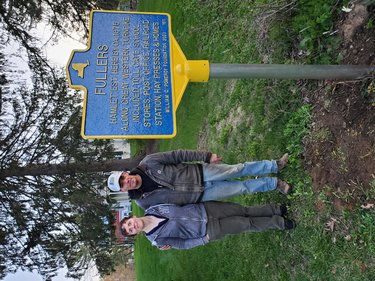Rustic Barn condemned, slated for demolition
— Photo from John Haluska
Lucinda and Ryan Caruso stand by a historic marker placed this year in front of their home that housed the Fullers post office and general store in the mid- to late-1800s. The Carusos have long been interested in buying the property neighboring theirs, which has the abandoned Rustic Barn.
GUILDERLAND — The Rustic Barn, slowly collapsing along Route 20 in rural western Guilderland, has been given a scarlet letter — X. The property was abandoned more than a decade ago.
“Not only was the building condemned by the town but also the county engineer signed off on that,” said Supervisor Peter Barber at the Sept. 5 town board meeting. “So it’s my understanding that the building is going to have a red X if it doesn’t have one already.”
The matter was raised yet again by John Haluska, a town resident active in Guilderland’s garden club and historical society and a gadfly when it comes to pointing out abandoned buildings in town.
The owners of a neighboring property, Lucinda and Ryan Caruso, who live at 6685 Fuller Station Road — their home housed the Fullers post office and general store in the mid- to late-1800s — have long been interested in acquiring the Rustic Barn property.
“We are currently in conversations with the County regarding the future of the property,” Ryan emailed this week in response to Enterprise questions. “I cannot speak further to the situation at this time.”
He did, however, go on to “clarify a few points,” stating, “Our understanding of the property, according to conversations with the town, is that the site is unbuildable. Due to the setbacks required from Route 20 and the adjoining wetlands on both sides that feed the Watervliet Reservoir, no building can be constructed on the premises. The only thing that can be done is to demolish the structure and plant some flowers.”
Caruso wrote further that Haluska does not speak for him and also stated, “The town condemned the building; the county has no involvement with that decision. Lou Vitelli, Guilderland’s building inspector, made that decision.”
At the board’s Aug. 15 meeting, Barber had explained that the town would be condemning the building but needed the Albany County engineer to sign off on it.
“Whatever costs are associated with that then will be attached to the property as a tax,” said Barber.
He explained that the county legislature had passed a law several years ago “that basically stopped communities from tearing down dilapidated buildings, then incurring a cost to remove them, and then sticking the county with the bill.”
Barber had said in August he was confident the county’s engineer would agree the building should be demolished.
Haluska asked in August about “deconstructing” the barn — part of which is thought to have been built in the 1700s — rather than demolishing it. “Deconstructing it, board by board, so that those boards, which many of them are usable …” said Haluska.
“If they are going to be condemning a building,” said Barber, “they’re not going to allow anybody inside the building to harvest and to remove those materials.”
At the Sept. 5 meeting, Barber estimated it would cost between $50,000 and $100,000 to demolish the building, which would probably be done by the town highway department working “along with an asbestos abatement affirm … to do air quality.”
“We would like to avoid those costs,” said Barber, noting that, because the county engineer signed off on it, the costs would be repaid. “But it’s better not to pay the money upfront,” said Barber.
History
The Rustic Barn has been empty since its owner, Herbert Young, who sold woodstoves, antiques, and lawn-care products out of the property, died in 2013; he had no children. In Young’s final years, when he was in a nursing home, the property fell into tax arrears.
The current assessment roll for Guilderland still lists Herbert Young as the owner of the one-acre Rustic Barn property at 4852 Western Turnpike and gives it a full-market value of $121,176.
The abandoned property contains a one-story house with slate roof, dating from the mid-19th Century, and the barn itself, which is older, as well as a two-story addition that seems to be from the 20th Century; all of those buildings are connected to one another, with the most recent section linking the original house to the barn. There are also several outbuildings in disrepair.
Ryan Caruso and his family moved to Guilderland in 2018, into what had been the old Fullers post office and general store, built in 1870. This year, an historic marker was placed in front of their home, marking the Fullers hamlet established in about 1875.
The Carusos’ property abuts the Rustic Barn property at 4852 Western Turnpike. Since moving into their home five years ago, the Carusos have cleaned up their own property as well as refuse from the neighboring Rustic Barn property.
Late in 2018, Ryan Caruso sent photos to the state’s Department of Environmental Conservation because he was concerned about chemicals he had come across — many large bags of fertilizer near the stream between the two properties as well as chemicals in and around the Rustic Barn house.
The stream feeds into the Watervliet Reservoir, which is Guilderland’s major source of drinking water.
Chemicals in the house, Caruso told The Enterprise in 2018, included bags of chlordane, a pesticide that was banned by the federal Environmental Protection Agency in 1988 and which is associated with gastrointestinal distress and neurological symptoms in the case of short-term exposure, and with non-Hodgkin’s lymphoma when exposure is chronic.
Another chemical in the house was Sevin, or carbaryl, an insecticide that is not banned, but that has been largely replaced by other, less toxic alternatives. Another was a broadleaf herbicide, 2,4-Dichlorophenoxyacetic acid, classed by the International Agency for Research on Cancer, but not by the EPA, as a possible carcinogen.
The DEC subsequently conducted a cleanup of the site.
In 2019, the DEC told The Enterprise that the agency had “worked with contractor National Response Corporation to remove pesticides contained inside the building, which had no harmful effects to the environment.
“In addition, and out of an abundance of caution, DEC also monitored the excavation and safe disposal of soil in the areas of potential impacts where fertilizer was stored and where an oil tank was located. Follow up tests at the site met appropriate standards and there was no harmful effect on the nearby Watervliet Reservoir drinking-water supply or any nearby waterbodies. The cleanup is now complete ….”
Caruso added this week, “Since the first DEC cleanup in 2018, I had them come a second time in 2020 as part of DEC’s Clean Sweep program and they removed the remaining chemicals from the property. This was another 2-3 tons of loose chemicals, mostly fertilizer and pesticides, stored upstairs in the barn.”
Also in 2019, Kent Spring, who grew up on the property and read the Enterprise coverage, wrote a letter to the editor with his recollections of the place.
“My father, Ralph Spring, owned the farm property on the southwest and northwest corner of Highway 20 and Fullers Station Road from about 1944 to 1976,” he wrote. “The farm had belonged to the Coss family until my parents purchased it in 1944. The John Jay-style house, with its broad front porch, was our home, and across Route 20 stood the Dutch barn and an attached two-story calf barn.
“In June 1955, an Esso truck, heading west, drove off Route 20, crashing into the northeast corner of the barn, destroying that corner and the huge granary inside. The driver was unhurt; the fuel didn’t explode. My father repaired the destruction with a farm stand called Springtime Farms.”
A number of the original hand-hewn beams — “beautiful pieces of wood” — were removed from the centuries-old Dutch barn after his father sold it, Kent Spring wrote.
He also wrote that the small structure attached to the barn was an addition built about 1955 by his father. “I learned how to pound nails on that project,” he wrote in 2019. “My father was a jack of all trades, including slate roofs. The ‘addition’ is still fairly sound structurally.”
Ryan Caruso has written several letters to the Enterprise editor, advocating preservation of historic buildings, such as at the Bender Melon Farm in New Scotland, or at least rescuing pieces of historic buildings that were being demolished like the Doctor Crounse House on the outskirts of Altamont.
At the close of the Sept. 5 public-comment session, Haluska suggested to the town board that a sign be placed on Route 20 near the Rustic Barn property, once it’s cleaned up, welcoming people to Guilderland.
“I don’t think so, because the town actually starts at least two miles further to the west …,” Barber responded. “I can think of at least 50 people I could name right now who would not be happy about them being lopped off.”



